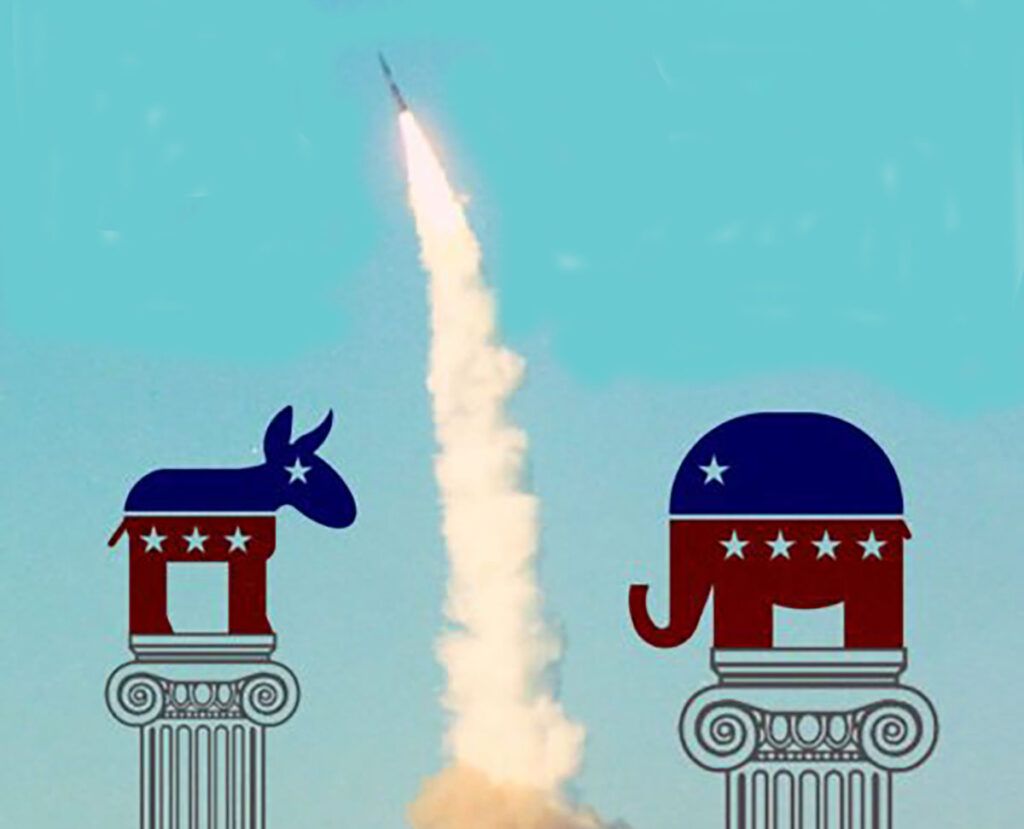The US presidential candidates are not confronting the nuclear threat that haunts the world
By Robert Jay Lifton | August 29, 2024

The candidates in the coming election in the United States have said little, certainly nothing coherently, about nuclear weapons. Yet those weapons continue to haunt us, even as they move in and out of our conscious awareness.
We are reminded of this disconnect by the recent revelation of a shift in the American strategy of “nuclear deterrence” to give greater emphasis to China because of evidence of its rapid build-up of the weapons.1 That strategy change suggests China has been granted the dubious status of player in the game of bringing an end to humanity.
This “nuclear end,” as we came to call it in the antinuclear movement, was oddly treated in the recent Musk interview of Trump. Trump spoke vaguely of “nuclear warming,” though he has constantly dismissed the danger of climate change. Musk referred to the relatively rapid rebuilding of Nagasaki as a thriving city, failing to recognize that reconstruction was possible only because of the existence of an outside world to bring the necessary energy and know-how for such rebuilding. The use of contemporary nuclear weapons would allow for no such outside world. And the statement also ignores the residual pain and nuclear fear brought on by the atomic bombing of that city.2
And in her Democratic National Convention acceptance speech, Kamala Harris committed herself to a military that “always has the strongest, most lethal fighting force in the world.”3 We do not know whether she had nuclear weapons in mind.
What are the nuclear truths that are still rarely taken into account?
Nuclear weapons represent a revolution in the human capacity for destructiveness. Whether it begins with battlefield use of relatively small nuclear weapons or with larger ones, a nuclear war is likely to bring about a “nuclear winter”—the blocking of the sun’s rays by soot and other debris blown into the stratosphere—bringing about the lowering of Earth’s temperature to an extent that agriculture and human life could no longer be sustained. There is also more recent research suggesting that even a “limited” nuclear war could bring about worldwide starvation, affecting hundreds of thousands or even millions of people.
From this standpoint, Robert Oppenheimer’s brilliant success in guiding his fellow scientists at Los Alamos to the creation of nuclear weapons was his also tragedy. He could never decide whether to go along with the society’s rendering him a hero or to insist on his guilt, as he did when he told President Harry Truman, “I have blood on my hands.”
The larger US society has the same conflict. It is unable to decide whether the weapons are crucial to keeping the peace and even keeping the world going—the US addition to what I call nuclearism—or whether their very existence, not just their use but their stockpiling, is what threatens our future. The latter idea is central to the treaty put forward by the United Nations banning the “use, possession, testing, and transfer of nuclear weapons under international law.”4 Recently 150 medical journals, including The New England Journal of Medicine, Journal of the American Medical Association, Lancet, and the British Medical Journal made a joint call for the elimination of nuclear weapons with an editorial statement: “The nuclear arms states must eliminate their nuclear arsenals before they eliminate us.”5
That reasonable advocacy of nuclear abolition could not of course abolish our capacity to rebuild the weapons. But such re-creation would be highly demanding, and abolition would make the world a much safer place even if the possibility of building new nuclear weapons existed.
One survivor I interviewed in Hiroshima told me how he looked down from a high suburb not long after the bomb exploded and was terrified to discover that “Hiroshima had disappeared. It simply no longer existed!” I was moved by his observation and developed my own mantra: “One plane, one bomb, one city.”6
In regard to the argument that nuclear weapons are necessary for “national security,” or that somehow your bombs are weapons of nuclear destruction and mine only serve peacekeeping, I think of a toast that was frequently made during the meetings of the International Physicians for the Prevention of Nuclear War (IPPNW). Either an American or a Russian delegate, it didn’t matter which, would get up and raise his or her glass and declare: “I drink to your health and to that of your leaders and your people—because if you die, we die, if you survive, we survive.” With a dash of gallows humor, the toast expressed the valid principle of shared security or human security, rather than the false idea of anyone’s national security.
Also in relation to those meetings, it is little known that Eugene Chazov, the head of the Russian delegation (who together with his friend and fellow cardiologist Bernard Lown had helped to create the international group) was transmitting our conclusions about human security to Mikhail Gorbachev, then president of the Soviet Union. Gorbachev took these principles seriously and made them his own.
Those conclusions have also been transmitted in the Chazov family, as his granddaughter, Olga Mironova, speaks to her commitment of carrying out his work and now serves as a co-president of IPPNW. She continues to do so from Moscow, suggesting, perhaps, that Putin allows her to do this work as part of a claim to Russian awareness of nuclear danger—while at the same time making periodic nuclear threats.
Dissemination of truths can take varied and surprising paths.
The truth I speak of here is factual truth about the weapons and our responses to them, as opposed to ideological or religious truth. In factual truth-telling, there is a certain amount of psychological benefit on the part of the teller that comes with an awareness of breaking out of dangerous widespread falsehoods. Truth-telling is also a means of breaking out of what I call psychic numbing, the inability or disinclination to feel that surrounds nuclear truths. That numbing, when extensive, can perpetuate the malignant normality that is routinized in those falsehoods.
Every American administration—for that matter every generation—is faced with a version of nuclear threat and has the opportunity to bring about its own version of dealing with that threat. Should the oncoming 2024 American election be won by a team concerned with nuclear truth-telling, it could render itself the first administration to advocate nuclear abolition—not unilateral disarmament but an international policy of eliminating nuclear weapons, as advocated by the United Nations. Not an easy goal to achieve, but one that could not be more appropriate for our nuclear-haunted world.
Editor’s note: This essay was originally published on the Psychology Today website.
Notes
- https://www.nytimes.com/2024/08/20/us/politics/biden-nuclear-china-russ…
- https://www.rev.com/blog/transcripts/elon-musk-and-donald-trump-intervi…
- https://www.nytimes.com/2024/08/23/us/politics/kamala-harris-speech-tra…
- https://disarmament.unoda
Together, we make the world safer.
The Bulletin elevates expert voices above the noise. But as an independent nonprofit organization, our operations depend on the support of readers like you. Help us continue to deliver quality journalism that holds leaders accountable. Your support of our work at any level is important. In return, we promise our coverage will be understandable, influential, vigilant, solution-oriented, and fair-minded. Together we can make a difference.
Keywords: 2024 presidential election, Donald Trump, Kamala Harris, nuclear truth-telling, nuclear winter, psychic numbing
Topics: Analysis, Nuclear Weapons















Pretty sure Trump brings this up pretty regularly.